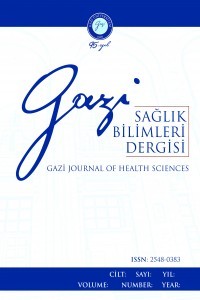ADÖLESANLARDA KRONOTİPE GÖRE ÖĞÜN ZAMANI VE BESİN TERCİHLERİNİN İNCELENMESİ
kronotip, adölesan, beslenme alışkanlıkları, öğün zamanı, besin ögeleri
EXAMINATION OF MEAL TIME AND FOOD PREFERENCES ACCORDING TO CHRONOTYPE IN ADOLESCENTS
kronotip, adölesan, beslenme alışkanlıkları, öğün zamanı, besin ögeleri,
___
- Roenneberg T, Merrow M. The circadian clock and human health. Current Biology. 2016;26(10):432– 443.
- 2. Gangwar A, Tiwari S, Rawat A, Verma A, Singh K, Kant S, et al. Circadian preference, sleep quality, and health-impairing lifestyles among undergraduates of medical university. Cureus, 2018;10(6):2856.
- 3. Mendes Silva C, Carliana Mota M, Tavares Miranda M, Lemos Paim S, Waterhouse J, Aparecida Crispim C. Chronotype, social jetlag and sleep debt are associated with dietary intake among Brazilian undergraduate students. Chronobiology International. 2016;33(6):740-748
- 4. Xiao Q, Garaulet M, Scheer F. Meal timing and obesity: interactions with macronutrient intake and chronotype. International Journal of Obesity. 2019;43:1701–1711.
- 5. Gontijo CA, Cabral BBM, Balieiro LCT, Teixeira GP, Fahmy WM, Maia YCDP et al. Time-related eating patterns and chronotype are associated with diet quality in pregnant women. Chronobiology International. 2019;36(1):75-84.
- 6. Nimitphong H, Siwasaranond N, Saetung S, Thakkinstian A, Ongphıphadhanakul B, Reutrakul S. The relationship among breakfast time, morningness-eveningness preference and body mass index in Type 2 diabetes. Diabetic Medicine. 2018;35(7):964-971.
- 7. WHO, The WHO STEPwise approach to chronic disease risk factor surveillance. Geneva: World Health Organization. Section 3: guide to physical measurements (Step 2). World Health Organization 2008. Avaible at: https://www.who.int/teams/noncommunicable-diseases/surveillance/systems tools/steps#:~:text=The%20WHO%20STEPwise%20Approach%20to,NCD%20risk%20factors%20in% 20countries Accessed on: 10/02/2021.
- 8. De Onis M, Onyango AW, Borghi E, Siyam A, Nishida C, Siekmann J. Development of a WHO growth reference for school-aged children and adolescents. Bulletin of the World health Organization. 2007;85:660-667.
- 9. Fernandez JR, Redden DT, Pietrobelli A, Allison D. Waist circumference percentiles in nationally representative samples of African-American, European-American, and Mexican-American children and adolescents. The Journal of Pediatrics. 2004;35(1):439–444.
- 10. Zimmet P, George Alberti KM, Kaufman F, Tajima N, Silink M, et al. The metabolic syndrome in children and adolescents–an IDF consensus report. Pediatric Diabetes. 2007;8(5):299-306.
- 11. Ashwell M, Hsieh SD. International Journal of Food Sciences and Nutrition Six reasons why the waistto-height ratio is a rapid and effective global indicator for health risks of obesity and how its use could simplify the international public health message on obesity. International Journal of Food Sciences and Nutrition. 2005;56(5):303–307.
- 12. Roenneberg T, Kuehnle T, Pramstaller PP, Ricken J, Havel M, Guth A, et al. A marker for the end of adolescence. Current Biology. 2004;14(24):1038–1039.
- 13. Dursun OB, Ogutlu H, Esin IS. Turkish validation and adaptation of Children’s Chronotype Questionnaire (CCTQ) Çocukluk Dönemi Kronotip Anketi’nin Türkçe Geçerlilik ve Güvenilirliği. 2015;47(1):56–61.
- ISSN: 2548-0383
- Yayın Aralığı: Yılda 3 Sayı
- Başlangıç: 2015
- Yayıncı: Gazi Üniversitesi
Doğaç KARAGÜVEN, İlker ÇETİN, Alper KAYA, Berk GÜÇLÜ, Burak AKAN
Multiple Sklerozlu Hastalarda El Mental Rotasyon Görevi
Büsra CANDİRİ, Engin RAMAZANOĞLU, Burcu TALU, Mehmet TECELLİOĞLU
Gebe Kadınların Sağlık Uygulamaları Ve Etkileyen Faktörlerin İncelenmesi
Sağlıklı Genç Yetişkinlerde Akıllı Telefon Bağımlılığının Parmak Duyusu Hassasiyetine Etkisi
ADÖLESANLARDA KRONOTİPE GÖRE ÖĞÜN ZAMANI VE BESİN TERCİHLERİNİN İNCELENMESİ
HEMŞİRELERİN İŞYERİ ŞİDDETİNE MARUZ KALMA DURUMLARI İLE İŞ DOYUMLARI VE İŞTEN AYRILMA EĞİLİMLERİ
Nigar ÜNLÜSOY DİNÇER, Refia Selma GÖRGÜLÜ, Aslıhan BOYACIOĞLU
Besin Ambalajlarında Sürdürülebilirliğe İlişkin Logo Varlığının İncelenmesi: İtalya Örneği
Seval AĞAÇDİKEN ALKAN, Özge İŞERİ, Meryem KIRMIZI
Persistent Postural Perceptual Dizziness Tedavisinde Vestibüler Rehabilitasyonun Etkisi
